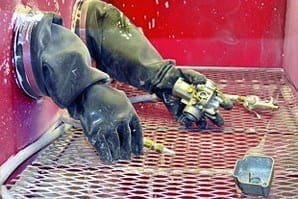
We’ve all experienced the ‘blocked jet’ feeling in a carburettor, the bike doesn’t work as we want it to, it’ll hesitate, splutter, pop, bang and any number of other odd sensations. For us in the off-road world this can mean dirt or water has invaded the space where only fuel and air should be. This is why fuel tanks and carburettors have a series of filters in between that hole at the top where you pour whatever your bike runs on, in and the jet system metering the stuff before it is sucked into the cylinder head.
These days, with modern ethanol enhanced petrol, there is another variable, the fuel can evaporate quickly leaving a deposit guaranteed to block any small drillings such as jets. Once this happens forget fine throttle response. Problem is while it is possible to clean out removable jets what about the drillings they go into? Not the easiest things to clean out, especially the ones that are stopped or ‘blind’ holes where nothing can be pushed through… we’re talking about a carb cleaning spray rather than a drill or file here.
What’s the answer?
There is a method to ensure total carb cleanliness and it uses ultrasonic technology to create a series of bubbles in a liquid. These bubbles pop and this cleans the surface of whatever is in there. Components are immersed in a cleaning liquid filled tank attached to the ultrasonic machine and the ultra sound waves do their work. The process doesn’t harm anything and will clean all types of materials that go to make up a typical carburettor, though it won’t remove the staining from the plastic fuel pipes as you can see in the pictures. It was fascinating to watch the process at work and as well as our carburettor being cleaned there were other bits and pieces being treated too. It was surprising to see the level of muck that came out of an admittedly old and well used Bing carburettor but one that didn’t seem too bad in the beginning.
What can you clean?
Almost anything can be cleaned using this process, the limiting factor is the size of the tank and the feasibility of actually getting ‘it’ whatever ‘it’ may be into the tank. Sticking with carburettor sized components though, Chris Clayden at CC’s Clean Carbs suggested the unit be inspected for cracks as the process will find imperfections in instruments and they can open up. This isn’t surprising once Chris had explained the process involves high frequency mini-explosions agitating the contamination free and drawing it out of the tiny orifices. The sound waves can actually be seen to be doing their job as once the machine is switched on the surface of the liquid ripples and dirt can be seen exiting the component leaving it clean and ready to be assembled.
Getting the best service
So, you want your carburettor cleaned, just haul it off the bike, tip out the old fuel – safely into a sealed receptacle – chuck it in a bag and address it to CC’s, right? Er, well you can but it’s better if you apply a little thought, CC’s can and will strip a carb for you but there is a charge for the service, though for our photo shoot Chris provided a job tray and some tools as we pulled it apart. It’s the same with reassembly, CC’s can do it but there is a charge. Far better you gently clean the carb first – a parts washer is fine – to get all the loose muck off then carefully strip it, making a note of the settings such as how many turns the air screw is out, lay it all out and take a picture of it so you can put it back together again, I understand even phones can take an acceptable pic these days.
Contact CC’s Clean Carbs
Carburettor Cleaners. Unit 7, Lascombe Estate, Highfield Lane, Puttenham, Guildford Surrey, GU3 1BB
Visitors are always welcome, but please call beforehand. Tel: 05602 051339
Email: [email protected]
Web: www.carbcleaning.com ![]()




